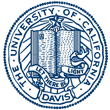
This REU program was funded through NSF PHY-1263201.
Students' names link to their final papers. Advisors' names link to the research group web pages.

Biological Physics
Naturally occurring proteins perform such a range of tasks that biotechnology is now exploring what else natural or designed proteins might be able to accomplish. Ideas include electronic applications, including non-toxic batteries, and methods of controlling or guiding chemical reactions. Sofia Cruz Tetlalmatzi (UNAM; adviser Daniel Cox) searched for new proteins with a beta-solenoid structure, where one potential application is as ultrathin insulating layers. Given our still very limited ability to predict the structure of an unknown protein, she began with a database of known beta-solenoid proteins. Using data mining techniques, she compared their amino acid sequences to those of other proteins with as-yet-unknown folded structures. She found a few examples similar enough that they might also be beta-solenoids, while at the same time different enough that they might have noticeable changes in behavior. Starting from the known structure of the similar protein, she then ran simulations and found that two of her proteins were likely to have stable beta-solenoid structures. Finally, she generated these two proteins in a laboratory, proving that they can be worked with experimentally. Further research will explore their potential for applications.
Complex Systems
David Gier (University of Kansas; adviser Jim Crutchfield) looked at what information patterns generated with a degree of randomness can give about the process that created them. He calculated entropy and entanglement for classical processes and their quantum analogs and found that in some sense the quantum version is more efficient in storing information.
Condensed Matter Experiment
The dispersion relation, or energy as a function of momentum, is linear for photons but quadratic for free electrons. Electrons in a crystal are another story. They move in a potential created by huge numbers of other electrons as well as the lattice of atoms and positive ions. These complicated interactions can give rise to collective effects such as superconductivity and magnetism. In certain materials, they can also lead to a linear dispersion relation for electrons, which by analogy to photons is sometimes described as electrons behaving as massless particles. Amelia Estry (Florida State University; adviser Nick Curro) studied such a material, the Dirac semimetal Na3Bi. She measured nuclear magnetic resonance (NMR) in the samples to explore the microscopic distribution of magnet ic fields. Since NMR is a bulk measurement, she was able to identify the several-da y time scale on which oxidation spreads throughout the sample. (A surface-sensitiv e measurement would find much faster sample degradation.) She also made a tentativ e identification of which peaks in her spectrum corresponded to which atomic sites in the crystal, a first step towards complete interpretation of NMR data.
Granular materials, such as sand, exhibit behaviors similar to solids, liquids, or gases, depending on the exact circumstances. Natasha Flowers (Carleton College; adviser Rena Zieve) revised image analysis code used in studying an artificial two-dimensional "sandpile" of ball bearings. The ball bearings are welded together into grains of different shape. The software challenge is to identify each grain type and location from digital camera images. Natasha made several corrections to both a heuristic algorithm and a neural network setup, so that the software now finds the vast majority of shapes correctly.

Atoms deposited on the surface of another material may spread evenly, or form islands of different shapes and sizes. Jimmy Miller (Rose-Hulman Institute of Technology; adviser Shirley Chiang) studied gold atoms on a germanium surface. He found that island shape can be controlled by temperature. The islands grow preferentially in a particular direction as temperature increases, becoming highly elongated. The shape change is reversible, with the islands becoming circular again once the temperature is lowered. At even higher temperatures, the islands began to move freely and combine into ever-larger gold regions. Understanding and gaining better control of these processes may eventually lead to applications as nanodevices.
May Palace (Salisbury University; adviser Rena Zieve) looked at oscillations along a single quantized vortex in superfluid helium. The vortex is suspended between the wall of a fluid-filled container and a wire used for the measurements. The goal was to move the wire abruptly, which would shake one end of the vortex and thereby excite waves along its length. Any motion of the end of the vortex along the wire could then be detected through its effect on the vibration of the wire. Surprisingly, significant vortex motion appeared even without deliberate excitation. May found that the source was tiny variations, less than one milliKelvin, in the temperature of the refrigerator used to cool the helium. This points to the possibility of using deliberate temperature changes to drive the vortex oscillations; the group's future work will explore this.
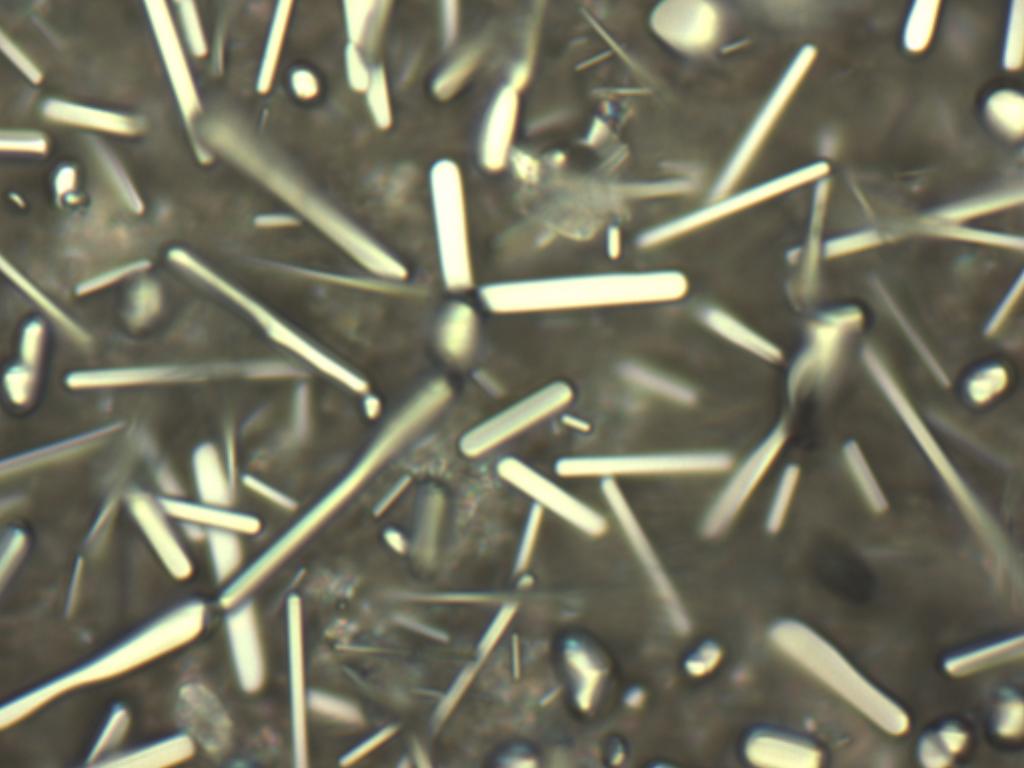
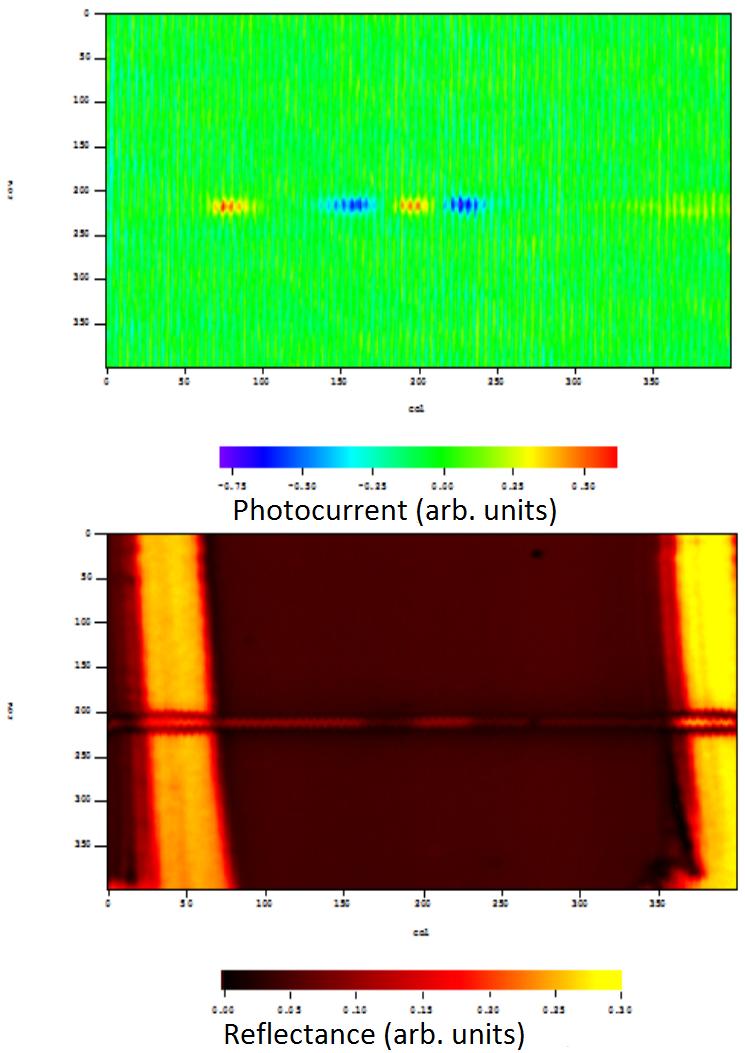
Vanadium dioxide has a metal-insulator transition at the very moderate temperature of 68 degrees Celsius. The very rapid change in resistance has potential applications, particularly in electronics. Clark Travaglini (Bard College; adviser Dong Yu) grew vanadium dioxide nanowires using chemical vapor deposition. The oxygen concentration during the growth proved to be a key influence on the nanowires; by varying it, Clark could change the dopant concentration and even switch the nanowires from the n-type materials grown by most other groups to p-type. After characterizing the nanowires through current-voltage curves and photocurrent microscopy, he suggested possible routes to improved performance.
Condensed Matter Theory
In two or three dimensions, it is impossible for an arrangement with translational symmetry also to have five-fold rotational symmetry. However, a high degree of local order is possible even without the long-range order required for translational symmetry. Quasicrystals (below left) are examples of such partially ordered structures with five-fold symmetry. Nicole Hartman (Southern Methodist University; adviser Richard Scalettar) looked at magnetic properties of such a system. Conduction electrons in any metal contribute to competing effects. They can screen local moments on atomic sites by combining with the local moment to form a singlet state. Alternatively, they can mediate interactions between local moments that can produce magnetic order. The competition between screening and order leads to complicated behavior in a variety of materials. As the interaction strength changes, there is often a transition from significantly screened, disordered moments to unscreened, ordered moments. Nicole found a transition to magnetic order which appears similar to that of a square lattice, despite the fact that in the quasicrystal the number of nearest neighbors varies from site to site.
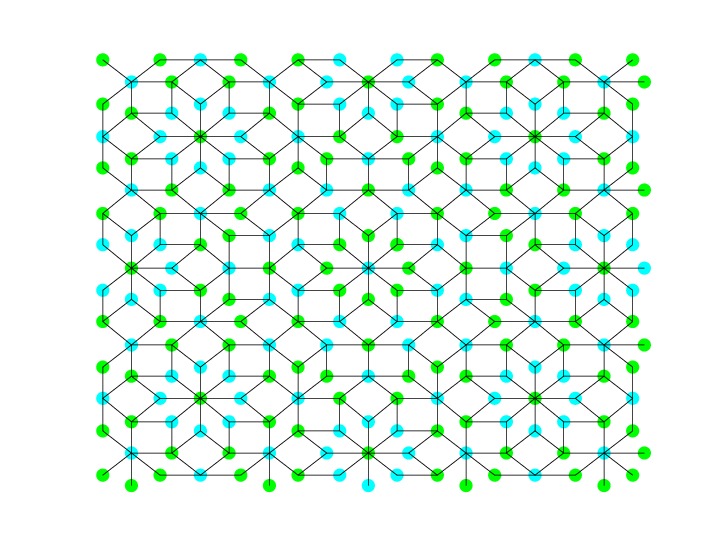
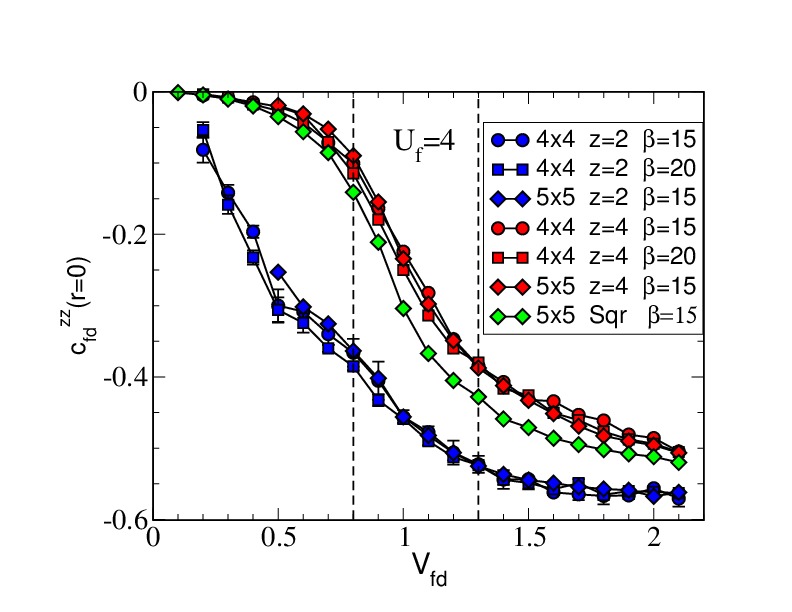
Entanglement entropy is that portion of entropy due to quantum entanglement of a multiparticle wave function. Nicholas Sherman (Solano Community College; adviser Rajiv Singh) partitioned several one- and two-dimensional spin systems into two pieces, and calculated the negativity, a particular measure of quantum entanglement. He confirmed the expected "area law," that the negativity scales as the size of the boundary between the two parts. His calculations further supported the idea of negativity as a quantum measure. It showed no feature at classical, finite-temperature transitions, and indeed decreased monotonically with increasing temperature. However, the two-dimensional system has a "quantum" phase transition at zero temperature, where the ground state changes from non-magnetic to magnetically ordered as a function of the interaction strength between neighboring spins. The negativity for the two-dimensional system peaked just at the interaction strength that causes the transition.
Cosmology
Lachlan Lancaster (Carnegie Mellon University; adviser Lloyd Knox) calculated how possible neutrino (CMB) interactions could appear in measurements of cosmic microwave background radiation. The confirmation that neutrinos can "oscillate," or transform among electron, muon, and taon neutrinos, means that neutrinos must have mass. In turn, having mass changes the possibilities for how neutrinos interact with other known particles. Lachlan posited the existence of a new particle which could give rise to the neutrino mass, parallel to how the Higgs boson leads to other massive particles. He explored consequences of such a particle, such as increased interactions of neutrinos. Altered interactions in the early universe would affect the observed CMB signals, which Lachlan used to set limits on how such a new particle could work.

Cosmic microwave background radiation has been an amazing success story for precision measurement, and for give and take between theory and experiment. Although its existence was first predicted in 1948, its detection in 1964 was accidental; Penzias and Wilson had not expected the apparently uniform background noise they observed. Subsequent calculations showed that cosmology, the behavior of the early universe, should leave its mark as slight anisotropy in the microwave background. Experiments detected this anisotropy, which has now been studied in great detail. The figure below, from the European Space Agency and the Planck Collaboration (http://sci.esa.int/planck/51555-planck-power-spectrum-of-temperature-fluctuations-in-the-cosmic-microwave-background/), shows both measured data (red points; note that for small angles the error bars become too small to see) and a fit to the standard model of cosmology (green). Only at very wide angles is there much room for improvement. Brigid Mulroe (Fordham University; adviser Lloyd Knox) worked on a comparison between the temperature fluctuation spectrum shown and the polarization spectrum. They should, in principle, be out of phase, with peaks in one spectrum matching troughs in the other. However, measurements find that they are not perfectly out of phase, and the discrepancy is more complicated than a single overall phase shift. Brigid calculated how two possible mechanisms would shift the spectra. Both effects seem present, although they do not entirely explain the data.

Nuclear Experiment
A key ingredient of collider experiments is calculating accurately exactly what observations are expected for a given model of particle interactions. Only then can unusual patterns be identified and assessed. Danny Dilone (CUNY Brooklyn College; adviser Manuel Calderon de la Barca Sanchez) worked on a new version of the event generation software, PYTHIA 8. He looked at production of charmonium as observed by the ALICE detector at CERN's Large Hadron Collider, and also upsilon measurements in the CMS detector at the same collider. In the latter case the calculations agreed quite well with the experimental observations, but for charmonium there were discrepancies, espe cially for collisions involving large numbers of nucleons. PYTHIA 8 gave better agreement than the older PYTHIA 6.4, but there remains room for improvement of the event modelling software.
Particle Experiment
The Large Underground Xenon (LUX) experiment aims to detect dark matter through its interactions with xenon nuclei. Despite its location deep in a mine and surrounded by tons of water, the LUX detector observes many background events, largely from the decay of trace radioactive impurities in the detector materials. Detecting dark matter requires a thorough understanding of the background and also, if possible, a way to distinguish dark matter candidate events from background events. Fortunately, most of the background arises through electromagnetic interactions, while dark matter would interact gravitationally. The two produce, on average, different ratios of detected electrons to detected photons. Rose Baunach (Whitman College; adviser Mani Tripathi) worked on a second method of separating the two, by analyzing the arrival time of the photons. Gravitational events cause an early burst of photons, with the rate quickly dropping. Electromagnetic events have a more even distribution of arrival times. Rose improved the identification of the photon arrival times, particularly for the difficult case when two photons reach the same part of the detector almost together. Combining the arrival time method with the charge/light ratio allows a two-dimensional characterization that vastly reduces the overlap region between electromagnetic and gravitational events.
Ethan Jahn (Indiana University of Pennsylvania; adviser Mani Tripathi) did early work towards making the upcoming dark matter experiment LZ more sensitive than its predecessor LUX. Both experiments aim to observe gravitational interact ions between dark matter particles and xenon nuclei. To combat the low interaction cross-section, the experiment uses 7 tons of liquid xenon. This in turn raises issues of how well the detectors at the edges of the very large container can respond to distant events and distinguish them from unwanted background. One background source, decay of polonium, yields an alpha particle. Ethan tested PIN diodes, which consist of an insulating layer separating p-type and n-type semiconductors, as one option for detecting the alpha and thereby tagging the event as background. The left image below shows the inside of the test setup. The eventual operating temperature will be 165 K, the boiling point of liquid xenon. Ethan found some degradation of performance as the diodes were cooled into this temperature range. The trouble may have come from condensation of water vapor, which will be tested with a more elaborate cooling setup.


Ben Kimelman (Muhlenberg College; adviser Bob Svoboda) worked on technical details for the ANNIE experiment, which will eventually do the detailed measurements of neutron-neutrino interactions needed to understand background levels in other particle physics experiments. He did careful testing of new photomultiplier tubes (PMTs). Although PMTs have been standard equipment for decades, for the level of precision required in particle physics any new version must be characterized afresh. Ben did noise measurements by placing the PMT in a dark room (above right, partly opened) and also measured the effects of magnetic fields. Ben also participated in a separate effort, travelling to Fermilab for the physical installation of one of the major components of ANNIE.